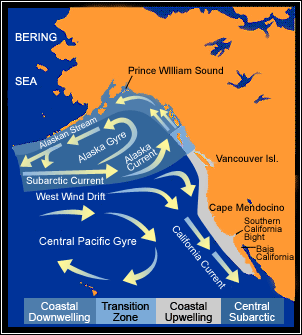You are here: Home › Stressors › Climate Change › Current Programs › (GLOBEC) Northeast Pacific
U.S. Global Ocean Ecosystems Dynamics (GLOBEC)
Northeast Pacific

Issue
For resource managers, it is critical to understand the effects of climate change on the distribution, abundance, and production of marine animal populations in areas important to the regional and national economies. In the NE Pacific Ocean, there is a close connection between the ecosystem dynamics in both of its gyres - the California Current System (CCS) and the Coastal Gulf of Alaska (CGOA). Tide gauge and satellite altimeter data suggest that the strengths of the boundary currents in these gyres covary out of phase on annual and inter-annual time scales. On inter-decadal time scales, there are data suggesting that zooplankton and salmon covary out of phase in the two boundary currents. The fluctuations in these populations, and others, coincide with basin-scale physical changes in atmospheric forcing and ocean conditions, although the mechanisms responsible for the coupled variability are not known.
Approach
The NE Pacific Program seeks (1) to understand the effects of climate variability and climate change on the distribution, abundance, and production of marine animals (including salmon and other commercially important living marine resources) in the eastern North Pacific; and (2) to embody this understanding in diagnostic and prognostic models, capable of characterizing ecosystem dynamics and responses on a range of time scales, including major climatic fluctuations.
Two research programs are active in GLOBEC NEP: one off the coast of Oregon in the northern California Current System (CCS), and one in the coastal Gulf of Alaska. The Oregon program is coordinated with NSF's Coastal Ocean Processes effort, which studies cross-shelf transport processes in the CCS. The GLOBEC NEP program also complements the CSCOR-funded Pacific Northwest Regional Ecosystem study, which focuses on a research area nearer to shore.
Management and Policy Implications
Because climate change effects are anticipated to be greater at higher latitudes, U.S. GLOBEC Studies in the Gulf of Alaska offer important opportunities to study potential impacts of global warming on marine ecosystems. Not only will this provide better information for the Alaskan salmon resources, it will allow comparison of the two systems to investigate the covariation between the two systems, and the effects of climate variability on the two systems. With new insight provided by GLOBEC research, indicators of ecological change will be developed to assist fisheries management and decision making.
Current Projects
California Current Program:- Coupled Physical/biological Dynamics in the Northern California Current System: A synthesis of seasonal and interannual mesoscale variability
- Effects of Meso- and Basin-Scale Variability on Zooplankton Populations in the CCS Using Data-Assimilative, Physical/Ecosystem Models
- Large-Scale influences on Mesoscale Structure in the CCS, A Synthesis of Climate-forced Variability in Coastal Ecosysems
- Changing Ocean Conditions in Northern California Current -- Effects on Primary Production and Salmon
- Latitudinal Variation of Upwelling, Retention, Nutrient Supply, and Freshwater Effects in the California Current System
- Synthesis of Euphausiid Population Dynamics, Production, Retention, and Loss Under Variable Climatic Conditions
- Juvenile Salmon Habitat Utilization in the Northern California Current - Synthesis and Prediction
- Scale-Dependent Dynamics of Top Trophic Predators and Prey -- Toward Predicting Predator Response to Climate Change
Gulf of Alaska Program:
- Nested interdisciplinary models for the Gulf of Alaska
- Variability in Shelf Transports in the Gulf of Alaska
- Topographic Control of Mesoscale Variability in the Gulf of Alaska
- Coastal Gulf of Alaska Egg Production and Viability
- Responses of the Neocalanus spp - Microzooplankton Community to Physical Forcing in the Coastal Gulf of Alaska
- Factors Affecting the Distribution of Juvenile Salmon in the Gulf of Alaska
- Relationship of Growth and Survival of Coho Salmon Utilizing the Coastal Gulf of Alaska
- Feeding, Growth, Condition and Energetics of Juvenile Pink Salmon in the Gulf of Alaska
- Gulf of Alaska Long Term Observation Program
Accomplishments
The 1997-1998 strong El Niño conditions provided an opportunity to evaluate the effects of oceanic variability on coupled physical-biological systems in the CCS. Long-term observation lines were in place in the northern California Current off of the Oregon coast, and in the coastal Gulf of Alaska. Investigators accelerated their planned sampling schedule to monitor the El Niño conditions. Comparisons of 1997-1998 El Niño data with previous El Niño events, the subsequent La Niña event, and data from non-El Niño years will help to identify which factors are strongly dependent on El Niño/La Niña, and how future El Niño/La Niña conditions may affect variability in salmon abundance. With improved prediction of ENSO events, and the resulting consequences to fishery populations, management can become more adaptive in response to natural variability.
In 2000, extensive field studies began off the coast of Oregon to determine the physical and biological characteristics that affect the oceanic life phase of Pacific salmon. Sampling occurred from Newport, OR south to Crescent City, CA, and included a three-ship operation comprising measurements of the physical environment, the phytoplankton, zooplankton, juvenile fish, and top predators (marine mammals and birds) that make up the ecosystem. Better understanding of this coastal oceanic environment will allow better planning and protection of the salmon resources in this area.
In 2001, the GLOBEC NEP program began field work in the Coastal Gulf of Alaska in a companion study. GLOBEC researchers are investigating variability in circulation patterns, and how they may influence zooplankton and salmon growth and survival.
For more information, contact:
NOAA/NOS/NCCOS/CSCOR
Dr. Elizabeth Turner
phone: (301) 713-3338
e-mail: coastalocean@noaa.gov

